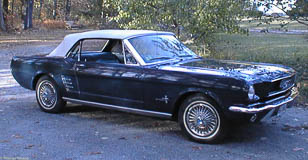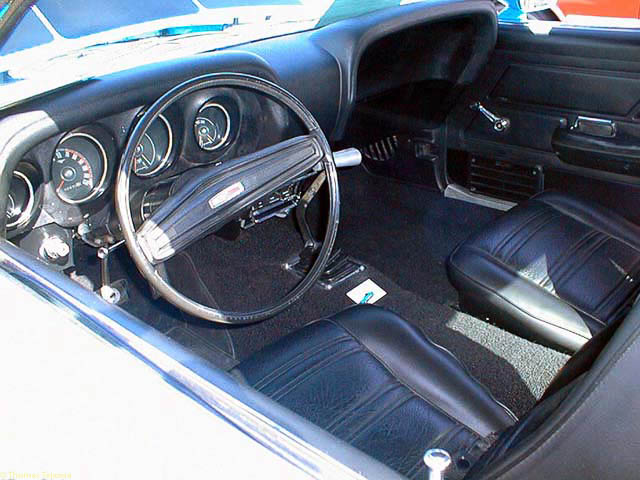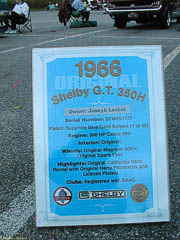Boss 302
In the 1960's, various "stock car" racing classes such as SCCA TransAm needed to be based on real "stock" cars that were available to the public with minimum quantities (like 1,000) sold the public. The actual quantities built
were 1,628 in 1969 and 7,013 in 1970.While Ford won this series in 1966 and 1967 (with Shelby built Mustangs), the Camaro won easily in 1968. Ford responded by building a special Boss 302 engine and including special handling
suspension on the Boss 302.
The Boss 302 Engine used cylinder heads based on the 351, although don't expect to get a Boss 302 just by bolting 351 Cleveland heads on your 302 or 5.0: the cooling passages are different (see something like the fordnatics mailing list archive for more information).
This car seems to be a 1970 model, based on the color (the 1969 model was only available in Wimbledon White, Bright Yellow, Calpyso Coral and Acapulco Blue) and the valve covers (1969 models had chrome valve covers). Given a choice,
I'd get one in white or Grabber Blue.
This white 1970 Boss even has the shaker hood.
Performance wise, the Boss 302 came in second place in the TransAm series in 1969, but won in 1970. Rated horsepower was 290hp at 5800 rpm (remember, back then they rated "gross horsepower", ignoring the power drain of the alternator,
water pump and so on). An important aspect of the Boss 302 was the handling and suspension, but in a straight line, the Boss 302 was a high-fourteen second car in the quarter mile, and 0-60 in a little under 7 seconds. The
Taurus SHO in stock form is a mid- to low-fifteen second car (although with mild changes and a good driver, people have run in the high fourteens), and also does 0-60 in under 7 seconds. The Boss 302 definitely looks faster
though!
I took pictures of this blue Boss a few years earlier. It might be the same car, but I don't know. The interior of this one is quite spartan: no glove compartment, and no radio. Any color you want as long as it's black. Seems to
be a real dilemma though, owning a car like this and not seeming to be able to drive it much.
1967 Shelby GT350
I'm not sure if this was an original Shelby or a replica, but it does have the Shelby badge on the inner fender. But because they're so rare, I assume this one was a replica. By 1967, the Shelby was on its way to becoming just
an option package, but still had engines that were not available in other Mustangs -- not even the GT's. The "HiPo" 289's in 1966 used mechanical valve lifters in the K-code engines. The Shelby's had an even more radical cam.
1967 GT350
This car shows what happens if you don't floss your teeth. What's the connection? Well, this car was restored by my dentist! He got it out on the west coast somewhere so I assume the sheet metal was all sound. Obviously lots of
work went into getting everything just so, including the chalk marks. He claims he doesn't use the dental tools in the restoration, but I don't believe him. It doesn't look like it's been driven more than 25 feet in the last
21 years, let alone every 21 days.
GT350 Race version
Shelby did build some special race versions of the GT350 in 1965 and 1966. I didn't make any notes as to whether this was an original GT350 R or not, but it's definitely set up for racing: no headlights, heavy duty aluminum radiator,
and pretty much open exhaust. The owner was brave enough to start it up and let someone try to drive it around the lot. It was definitely LOUD, much louder than any of the other cars I've heard at a car show.
However, there is at least one thing even a plain six cylinder Mustang can do better than this: idle. The guy had to keep revving the engine to keep it running, and after stalling half a dozen times trying to get out of the parking
space without crashing into the next row of cars, the owner took over and made one turn around the parking lot. I think the slowest he could get it to go (without just coasting) was about 25 MPH.
Definitely a completely different animal from the Mustang my old seventh grade English teacher drove.
1966 Shelby GT350H (Hertz rental car)
After Carroll Shelby made a few GT350's for racing in 1965, the Hertz rental car company heard about the cars and arranged to buy some for their rental fleet. There are numerous legends about these cars, maybe even true, about
people renting them for the weekend to go racing, or more outrageously, swapping out the highly modified engine for a plain six cylinder. This license plate frame supports the legend, but I can't see Hertz promoting this.
- One history of the Shelby Hertz cars.
1968 Shelby GT500
In high school, I used to walk past a Lincoln Mercury dealer that had a GT500 this color in the lot. It was even a convertible. I didn't have a driver's license, so I only vaguely wanted that car rather than having a full, deep seated
lust. Since I only lived a little over a mile from school, it would have been about as silly as the Bill Cosby routine where he wanted a car that would go at least 180 MPH so he could get to work in less than a minute (Cosby
got a specially made Shelby Cobra that went 200 MPH, and Bill used it for one of his comedy routines).
GT California Special
Ford made a number of special versions of the Mustang for different areas of the country in the late 60's. The GT/California Special is one of the most striking with a Shelby-style rear deck and simulated brake scoops. This particular
car is absolutely breathtaking. Sure, it lives in a trailer now, and therefore looks immaculate. This one has a 390 cubic inch V8. Personally, I think it would be a little more interesting with a 4 barrel 302. After 1968 and ignoring
the Boss 302 engines which were very different, Ford didn't have a 4 barrel 302 again until 1983. Of course, 1968 was the last year for the "small" big block 390's in Mustangs as well.
1966 GT Convertible
The owner of this car had been traveling all over the country looking for a GT, and ended up stumbling on this one after he'd basically given up. I'm not sure whether many GTs would have had the extra luggage rack. The trunk is small enough
though that you'd want extra space.
1967 K Code
At first, this looks like just another fastback. Maybe you notice the GT package (fog lights and side stripes). While this wasn't the end of the line for the 289 (which Ford used one more year in Mustangs before replacing it with the now
famous 302), this was the last year that the 289 "HiPo" engine with "K" in the Vehicle Identification Number was used. Ford used the 390 cubic inch FE (for Ford/Edsel) as their top of the line engine. Shelby still used the K code as
the base of their engines before jumping all the way to the 428 engine the following year for the G500. The close-up shows the VIN stamped into the inner fender with the model year, plant code and engine code highlighted.
Mustang II
If the late 60's were the heyday of Detroit musclecars, the 70's were the dark ages, largely brought on by rising gas prices. From 1974 to 1978, Ford came out with the Mustang II. They advertised it as returning to the roots of the original
Mustang, with a smaller body and smaller engine. The reaction at the time was it was just a slight sheet metal change on top of Pinto, forgetting that the original Mustang was just different sheet metal for the Falcon, Ford's economy
car that was the equivalent to the Pinto.
Although Ford built over a million Mustang II's (compared with one million Mustangs by the end of the 1966 model year), you don't see many Mustang II's at car shows. They're mostly unwanted and unloved, except for their front suspension
and steering which are pretty much the standard replacement for street rodders who want independent front suspension. In fact, the Mustang II front end is so popular that their are reproductions of these being built, even if few people
want anything to do with any other parts of these cars.
SVO Mustang
By the mid 80's, Ford started to come out of the dark ages introducing the "5.0 H.O.", daring to produce a small car with a V8 engine tuned for more power, and not just to power a land yacht. At the same time, Ford's Special Vehicle Operation
(SVO) did some work with turbo-charging a mid sized 4 cylinder engine. The SVO Mustangs were built from 1984 to 1986. I don't know which year this car is. They did quite well compared with the 5.0 HO, but couldn't compete with a 351.
In any case, it's much easier to sell 8 cylinders as a muscle car. However, it really is amazing at how much space is left in the engine bay of the SVO. And with the engine must closer to the center of the car, they're supposed to
handle real well.



































